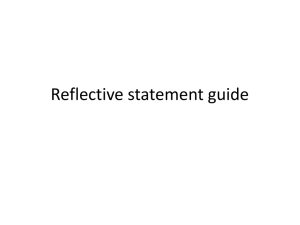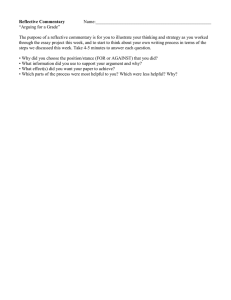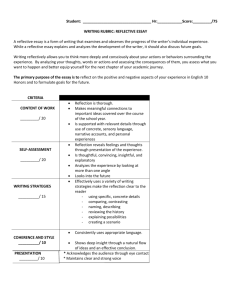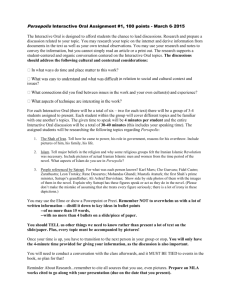WA & RS Submission Guidelines
advertisement
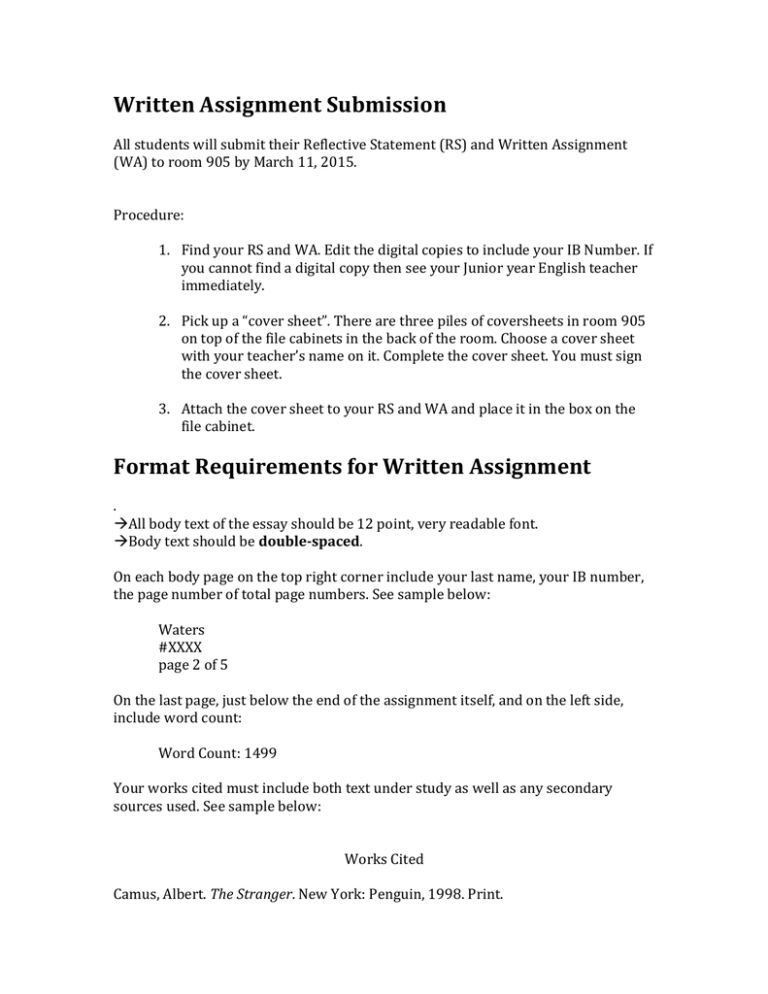
Written Assignment Submission All students will submit their Reflective Statement (RS) and Written Assignment (WA) to room 905 by March 11, 2015. Procedure: 1. Find your RS and WA. Edit the digital copies to include your IB Number. If you cannot find a digital copy then see your Junior year English teacher immediately. 2. Pick up a “cover sheet”. There are three piles of coversheets in room 905 on top of the file cabinets in the back of the room. Choose a cover sheet with your teacher’s name on it. Complete the cover sheet. You must sign the cover sheet. 3. Attach the cover sheet to your RS and WA and place it in the box on the file cabinet. Format Requirements for Written Assignment . !All body text of the essay should be 12 point, very readable font. !Body text should be double-­‐spaced. On each body page on the top right corner include your last name, your IB number, the page number of total page numbers. See sample below: Waters #XXXX page 2 of 5 On the last page, just below the end of the assignment itself, and on the left side, include word count: Word Count: 1499 Your works cited must include both text under study as well as any secondary sources used. See sample below: Works Cited Camus, Albert. The Stranger. New York: Penguin, 1998. Print. The Reflective Statement The purpose of the reflective statement is to explore how the interactive oral deepened your understanding of the work under study. You will write a 300-400 word reflective statement after each interactive oral. The reflective statement on the same work as your IB final writing assignment will be submitted for external assessment. In terms of an IB assessment, the reflective statement is worth 3 points. The reflective statement must respond to the following question as posed by IB: “How was your understanding of cultural and contextual considerations of the work developed through the interactive oral?” What does that mean? • How did class discussions (the IOs) about background information help you to understand the work more deeply? • What facts about the author’s life helped you understand the work better? • Make connections between Kafka’s work, style and technique and the contextual information you learned about. • Convey a sense of energy and enthusiasm for your learning. Reflective Statement Rubric IB score 0 1 2 3 To what The work Reflection on Reflection on Reflection on extent does does not the interactive the interactive the interactive the student reach a oral shows oral shows oral shows show how standard superficial some development his/her described by development development of the understanding the of the of the student’s of cultural descriptors. student’s student’s understanding and understanding understanding of cultural contextual of cultural of cultural and elements was and and contextual developed contextual contextual elements. through the elements. elements interactive oral? (The word limit for the reflective statement is 300–400 words. If IB notes the word limit is exceeded, 1 mark will be deducted.) • It is, therefore perfectly acceptable, even necessary, to respond with, “My understanding was developed …” • It is not a bad idea to list all of the various topics included in the IO. You may choose which ideas you focus on. You need not discuss every topic. RF Guidelines • Include proper heading: I.B. Learner March 12, 2013 Kafka Reflective Statement • Include a typed word count at the end of your RS: Word count: 375 • • Most important: Refer directly to the interactive oral discussion. (This is not a paper about a piece of literature; it’s a paper about a discussion.) Although this is much shorter than a full length essay, it should be well organized and structured much like an essay. Be sure to offer keen, clear topic sentences. • I have seen many examples of reflective statements on the IBO, only some of them have included quotes. Refer to the aspects of the novel that the IOs have helped you understand more deeply. Discuss the contextual information that you have learned in relation to the text. • This year we may need to submit the RS and the written assignment electronically. You must be sure to save your writing in several different places. • Tighten your prose by not repeating yourself. • You may use first person singular pronouns (I, me, my, etc.). The prompt is, “How was your understanding of cultural and contextual considerations of the work developed through the interactive oral?” Written Assignment Rubric – HL and SL (first examinations 2013) Criterion A: Fulfilling the requirements of the reflective statement • To what extent does the student show how 0 does not reach standard 1 Reflection on the interactive oral shows superficial development of the student’s understanding of cultural and contextual elements. 2 Reflection on the interactive oral shows some development of the student’s understanding of cultural and contextual elements. 3 Reflection on the interactive oral shows development of the student’s understanding of cultural and contextual elements. does not reach standard 1-2 The essay shows some knowledge but little understanding of the work used for the assignment. does not reach standard 1-2 There is some mention, but little appreciation, of the ways in which language, structure, technique and style shape meaning. 3-4 The essay shows knowledge and understanding of, and some insight into, the work used for the assignment. 3-4 There is adequate appreciation of the ways in which language, structure, technique and style shape meaning. 5-6 The essay shows detailed knowledge and understanding of, and perceptive insight into, the work used for the assignment. 5-6 There is excellent appreciation of the ways in which language, structure, technique and style shape meaning. their understanding of cultural and contextual elements was developed through the interactive oral? Note: The word limit for the reflective statement is 300–400 words. If the word limit is exceeded, 1 mark will be deducted. Criterion B: Knowledge and understanding • How effectively has the student used the topic and the essay to show knowledge and understanding of the chosen work? Criterion C: Appreciation of the writer’s choices • To what extent does the student appreciate how the writer’s choices of language, structure, technique and style shape meaning? Criterion D: Organization and development • How effectively have the ideas been 0 does not reach standard 1 There is some attempt to organize ideas, but little use of examples from the works used. 2 Ideas are superficially organized and developed, with some integrated examples from the works used. 3 Ideas are adequately organized and developed, with appropriately integrated examples from the works used. 4 Ideas are effectively organized and developed, with well-integrated examples from the works used. 5 Ideas are persuasively organized and developed, with effectively integrated examples from the works used. does not reach standard Language is rarely clear and appropriate; there are many errors in grammar, vocabulary and sentence construction, and little sense of register and style. Language is sometimes clear and carefully chosen; grammar, vocabulary and sentence construction are fairly accurate, although errors and inconsistencies are apparent; the register and style are to some extent appropriate to the task. Language is clear and carefully chosen, with an adequate degree of accuracy in grammar, vocabulary and sentence construction despite some lapses; register and style are mostly appropriate to the task. Language is clear and carefully chosen, with a good degree of accuracy in grammar, vocabulary and sentence construction; register and style are consistently appropriate to the task. Language is very clear, effective, carefully chosen and precise, with a high degree of accuracy in grammar, vocabulary and sentence construction; register and style are effective and appropriate to the task. organized, and how well are references to the works integrated into the development of the ideas? Note: The word limit for the essay is 1,200– 1,500 words. If the word limit is exceeded, 2 marks will be deducted. Criterion E: Language • How clear, varied and accurate is the language? • How appropriate is the choice of register, style and terminology? (“Register” refers, in this context, to the student’s use of elements such as vocabulary, tone, sentence structure and terminology appropriate to the task.)
